|
Our Website is being moved. Please click here to view our new website
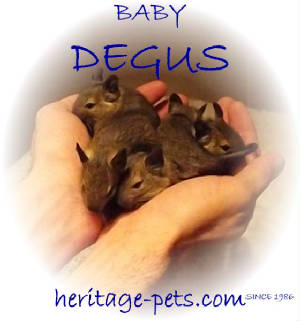
Availability ...
We will have babies ready for new homes June 2017. All are normal / agouti.
$25.00 each.
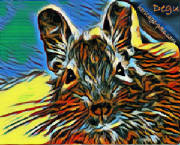
About Degus
There are several known sub species of Degus. Octodon degus is the type most commonly kept as pets, therefore we will focus
on the Octodon degus, on this page.
Classification:
Kingdom: Animalia (All living or extinct animals)
Phylum: Chordata (Animals that have some stage of development of a notochord and central nervous system)
Class: Mammalia (All warm-blooded vertebrates characterized by mammary glands in the female)
Order: Rodentia (Animals characterized by having a single pair of incisor teeth in the upper and the lower jaws that
never stop growing. These teeth are designed and typically used for gnawing)
Suborder: Hystricognathi (Specific species of rodents that are distinguishable by the bone structure of their skulls and
jaw muscles)
Parvorder: Caviomorpha (This is the order that unites all South American hystricognaths. - There is some speculation as
to whether Caviomorpha should truly be considered under the order of rodents or that perhaps it should be re-listed as a separate
order)
Family: Octodontidae (Thirteen species of rodents belonging to this family are recognized and they are restricted to
southwestern South America)
Genus: Octodon (The best-known of the four members of octodontid rodents, native to South America, is the common degu
Species: O. degus (Common Degus)
Binomial Name: Octodon degus
Common English Names: Degu, Degus, Bushy-tailed Rat, Common Degu
The pluralism for Degu is Degus.
A group of Degus is referred to as a herd, a group, or a colony.
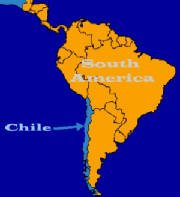
Natural Distribution:
The naturally occurring species of Degu is native to South America where it can be found living in small herds, consisting
of five or more animals per group, on the lower slopes in the Andes Mountain range in Central Chile. They thrive best in
a semi arid, scrubland environment but can also be found living in areas that have been disturbed by farming and grazing.
Appearance:
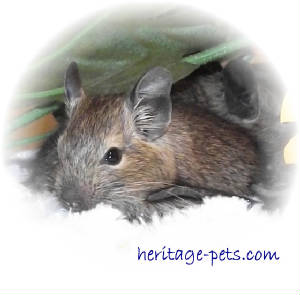
The Degu's appearance is a little hard to describe. In a lot of ways it looks like an overgrown Gerbil crossed with a pudgy
little Squirrel. Adults weigh approximately 220-250 grams (7 ¾ ounces to 8 ¾ ounces. Including head and tail they measure
approximately 25 cm to 31 cm (10 to 12 inches). Not including a tail, they measure approx. 15cm (6 inches).
A Degu's front legs are shorter than its back legs. They have five clawed toes on each of their four feet. Their front
legs are slightly shorter than their back legs. The toes on their back feet are lightly covered in bristly fur. Their ears
are quite large for a small animal of similar size. Their coat is short and silky. The natural or wild colour variety of a
Degu is agouti or grey-brown tinged with bronze on the back and creamy yellowish tan to off white on the belly. In recent
years, breeders have been working with colour genetics and have established lots of new colour varieties. There now exists
Sandy, Blonde, Piebald, Blue and White colour morphs.
Sexual Dimorphism:
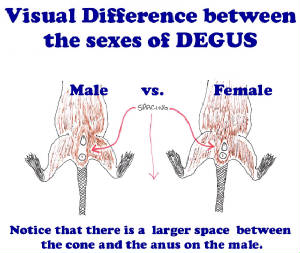
You can not verify the gender of Degus by simply looking at them. However, there are visual differences between the male
Degu and the female Degu. If you closely examine their genital region, you will notice that there are two distinct areas on
both sexes. One is an anus the other is a cone shaped bump or protrusion that houses and protects the genitalia. There is
a larger space between the anus and the genital bump on the male. While there can sometimes be a bit of a space between the
anus and the genital bump of the female, the space is usually much smaller than that of a male and often there is no space
at all. On mature animals there is also a small slit on the bump. If the animal is mature enough the slit/opening is noticeable
and the male's opening will point towards the tip and belly, while the opening on a mature female will be on more of an angle,
with the opening directed at her tail.
Having spent decades keeping and raising Degus, we are usually very accurate at determining the sex of a baby Degu. However
even for us, determining the sex while they are immature or still small and not yet fully developed, can be challenging when
it is time to visually sex a Degu.

Personality & Social Structure:
Degus are diurnal creatures; meaning that unlike nocturnal animals who are most active at night, Degus are mostly active during
the day. They are especially active during the morning and later afternoon /early evening. They do not hibernate and are active
all year round. They can be seen foraging for food, constructing their elaborate nests and digging tunnels during the daylight
hours.
Degus are herd animals. They live in colonies that can easily consist of up to a dozen or so individuals. Most often the
group members have a family connection but new, non-threatening, non-aggressive animals are often excepted and included as
a part of the herd. Each individual animal in the colony has a role to play and is expected to fulfil specific duties. Being
that Degus have evolved to highly social animals they do not like being by themselves. They need friends. Degus will learn
to appreciate their human counterpart and include their human friend in their everyday activities, but even though they do
accept companionship from their human friend, they still prefer and enjoy the constant companionship that only another Degu
can provide.
In a breeding situation, there are very few times that a mother needs to be separated from the herd. Everyone helps raise
the babies! Every member of the colony has a role to play in rearing, protecting and educating the babies and they all help
keep watch over the younger members of the group. They also have their own way of communicating with one another. While body
language certainly plays an important part of communication between Degus, these furry little animals have a language that
consists of different sounds such as chirps, squeaks, and lower octave squeals. While they are not noisy or very loud, each
sound is very distinct and if listened to closely, the sounds that they use seem to form clear Degu sentences that everyone
in the colony including the human caregiver can easily learn to recognize. In a way, Degus have their own very distinct vocabulary.
Besides being highly social, Degus are extremely intelligent. They are constantly learning and it is well documented that
they have very good memories. A Degu can be taught tricks and quickly learn to recognize peoples faces, smells and sounds.
They will learn and remember who has been good to them and who has been not so nice. Being that they do talk and send signals
to one another, they will tell everyone in their colony to be aware of an individual human. They are certainly not afraid
to let you or other group members know how they feel by signally your approach with chirps and purrs when they like you but
if you are not so nice, they will posture and let out more of a low-pitched squeal and rumble to the group to warn everyone
that a not so nice person or animal is closer. ...So always be nice to your Degus!
When first introduced to new people or other animals they can be a bit hesitant at first. They are creatures of habit;.
When it comes to their social hierarchy, trust needs time to be built and they don't always take kindly to intruders.
It can take a while for a Degu to warm up to a new person. This can vary between a few minutes to a few weeks but if or
when they trust and accept a new human as a new group member; they form strong bonds and build long lasting connections.
Not many species of small furry exotic pets show too much excitement when seeing their caregiver again, after he or she
has been away for any extended period but Degus do!
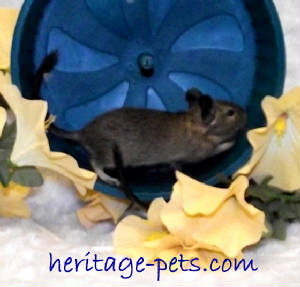
Life Expectancy: - A long-lived Rodent
In the wild, the naturally occurring species of Degu could live for approximately 6 to 8 years or more. Some have been known
to live more than 10 years. However, life expectancy in captivity is unfortunately a lot less. This is mostly because we humans
often associate love with food and sharing that food with things we love and care about is not always a good thing for a Degu.
In a sense, many of us pet enthusiasts try to humanize our pets but they are not designed to be human. Their dietary needs
are quite different. They have not evolved to digest foods the same way that humans do. There are many human food items that
they can not process and sometimes, because of our well-meaning intentions, we often unintentionally don't end up feeding
them properly. By giving too much variety too often or offering too many treats too often, combined with the fact that they
do not get enough exercise, many degus develop health problems. These health problems can go on undetected for quite a while
and many pet Degus don't live past 5 or 6years.
Some species of animals benefit by living in captivity but because Degus are similar to humans in that they enjoy eating
and will try everything. However that is not a good thing for them. They are naturally designed to eat a limited variety of
poorer quality, high fiber foods that have a very low sugar content. We may in fact be shortening their life expectancy, by
as much as a few years, when we offer them things they should not be eating.
Nutritional Requirements/Diet: - The more fibrous the better.
| Fresh Veggies- Hay- Fresh Greens |
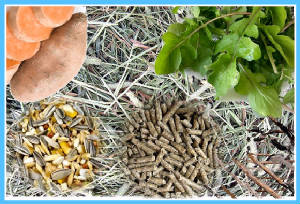
|
| Seed - Hay- Degus Pellets - Twigs |
FRESH CLEAN WATER must be available always.
Degus are true herbivores. In the wild, Degus usually feed on the ground where they feed on grass, bulbs, tubers and other
green vegetation but they will climb into the branches of shrubs and small trees to feed on leaves, bark seeds and some fruits.
In captivity, their diet should consist of good quality hay, which must be made available always. Their daily food supply
should be specially formulated pellets or a mixture guinea pig and chinchilla pellets that do not contain fruit. Fruits and
other sugary food items should be limited to treats that are offered sparingly but avoided as a part of their everyday diet.
Be sure to read the food label to make certain that the pellets do not contain added sugars (molasses, honey, fructose, glucose,
etc.)
Degus should be offered a fresh supply of uncooked root vegetables (sweet potato and tubers), a green leafy vegetable
(ideally not too much from the cabbage family) DAILY!
Many weeds such as plantain and dandelion are a welcome treat but these weeds must be cleaned and free or insects, herbicides,
pesticides and other chemicals. Organic is a safer alternative.
Fresh fruit can be offered as a treat but very sparingly and in tiny amounts. Fresh fruit is better because the sugar
content is not as concentrated in fresh as it is in dried fruit.
Degus should always have chew toys. These are necessary for keeping their teeth from overgrowing. Pressed hay cubes, organic
fruit tree branches, twigs and pumice chew stones should be readily available.
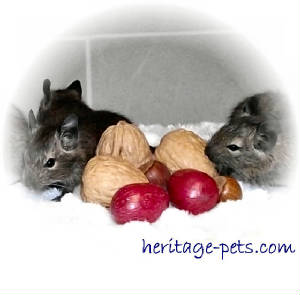
Housing / Cage Set-up:
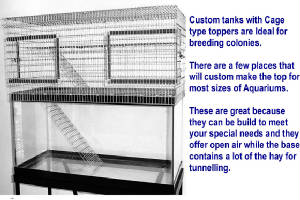 Degus do need to be housed in a chew proof cage. Like most rodents, their teeth continuously grow and they need to gnaw, so
providing them with a plastic or wooden cage is not always ideal. Large solid bottom, open air metal or a glass tank fitted
with a cage (open-air) topper is ideal. Providing that you can adequately care for the cage and maintain a high degree of
cleanliness, then the bigger the better. Obviously, a bigger cage will certainly provide more room for Degus and it is also
much more interesting for the owner, who can design a variety of very interesting set ups. Whether the displays are natural
looking or they are equipped with lots of safe, brightly coloured, commercially available pet toys, more room equals more
fun for the animal and the caregiver.
The bottom of the cage should contain safe non-toxic, absorbent bedding or substrate and additional hay for tunneling
and burrowing in. They construct an elaborate, communal burrow system for the colony to use. They move, chew and shred the
hay and twigs to form new nesting sites all the time. Having a choice of a couple of nest boxes, large tubes or hide huts
is another must for the Degu who does like to sleep in an out-of-the-way, private space.
Degus are quite active and need to run, jump, and climb. They like to explore and they do exercise a lot. Their cage should
be equipped with a solid exercise wheel or if the cage can accommodate them, a few exercise wheels. We loosely fill our cages
with lots of natural items such as fruit branches, wooden platforms etc. and we change them often because we feel that the
changes help provide the animals with some extra stimulation and environmental enrichment. When setting up your habitat, be
sure you have plenty of room for your Degu to comfortably access his food and water supply. We offer food and water in non-tip
ceramic bowls. Our animals also have access to a water bottle.
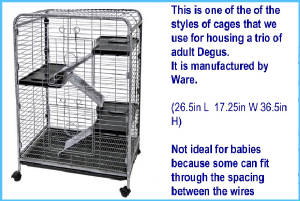
Temperature / Lighting Requirements:
The ideal temperature range to house a Degu in should be between 15 to 25 degrees Celsius. They can easily adapt to the ambient
room temperature that is preferred by most humans, 18 -22 degrees Celsius. Due to their inability to sweat, they are extremely
sensitive to high temperatures and can quickly develop heat stroke. Most Degus find it challenging to endure temperatures
more than 25 degrees Celsius for long periods of time and the more the thermometer rises so does the risk of heat stroke.
Especially during the summer months when high temperatures and heat waves are more likely, be sure to provide your pet Degu
with cooling stones and lots of cool water. When high temperatures are expected, whenever possible, simply move the cage to
a cooler area in the home.
Degus should be housed in an area that is brightly lit with natural occurring light. Supplemental light is not usually
needed if the animal is not housed below ground in a basement. They should never be housed in direct sunlight, close to or
in front of a window. Nor should they be housed close to heat or air-condition vents.
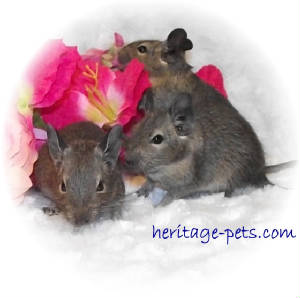
Grooming:
Degus groom each other on a regular basis but they also prefer a waterless bath. A few times a week provide your Degus with
a specifically designed small animal dust to roll in to bathe. Contrary to what we think of dust, a dust bath does not make
the pet dirty, it helps absorb dampness and loosen or dislodge debris that could become lodged in a Degu's coat. If you provide
a shallow bowl that contains a small amount of small animal dust bath the Degu will do the rest. He will roll and shake hoping
to dislodge anything in his coat that should not be there. Remove the dust bowl after a few minutes and let it air dry for
a day or two before offering it to your pet again. You can leave the bowl in the cage but it is almost guaranteed that your
pet will dig and play with it until it is all over the cage. That is fun for the Degu but it can become time consuming to
clean and it can get a bit costly.
Costs to Consider:
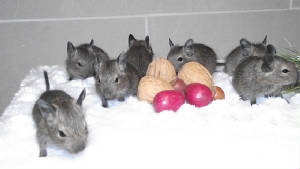
A Degu, depending on the colour variety will likely cost around $30.00 each and up.
All animals should go to a veterinarian for a check up annually and these prices do vary!
The cost to set up can vary but you can expect to pay in the neighbourhood of $150.00 or more for a decent set-up (including
the cage, a few toys, sleeping dens, bedding, food, etc.).
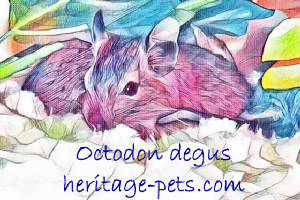
Below are images of some of the things, besides food and a cage, that you may want to consider for your pet degus.
|

